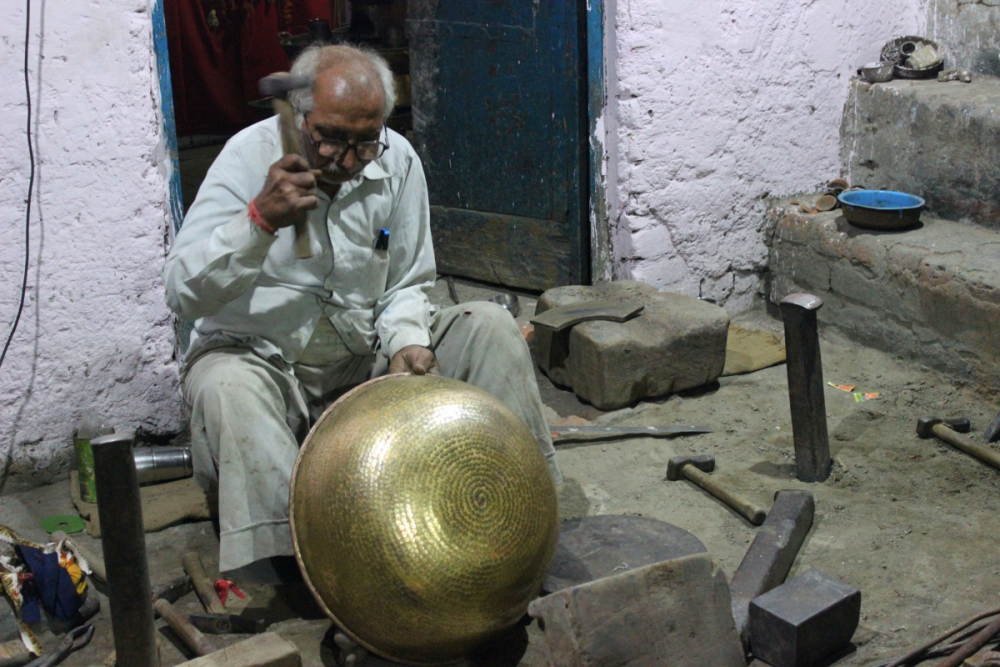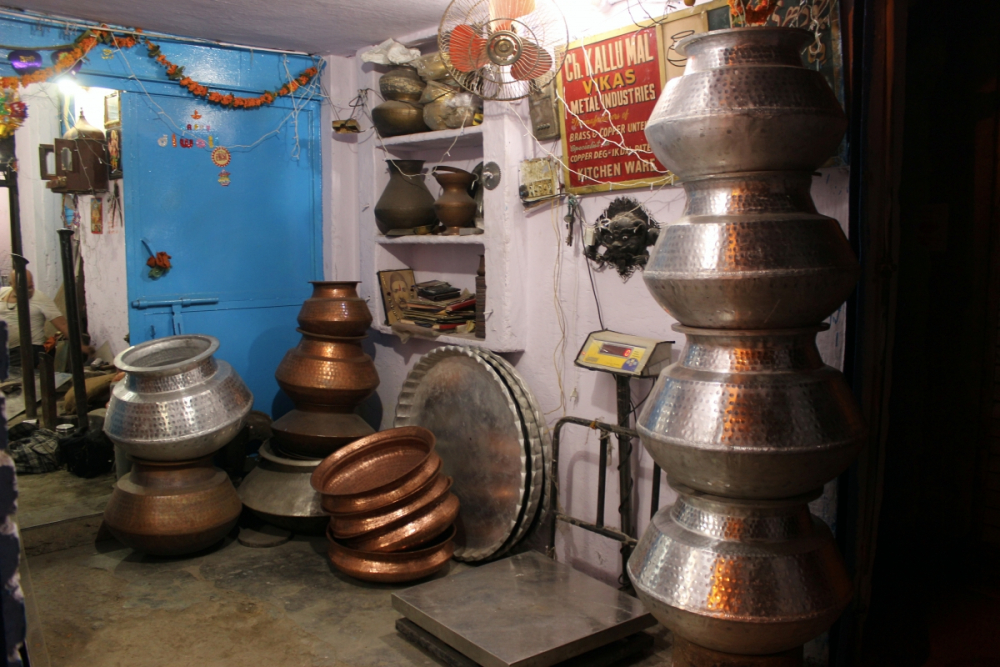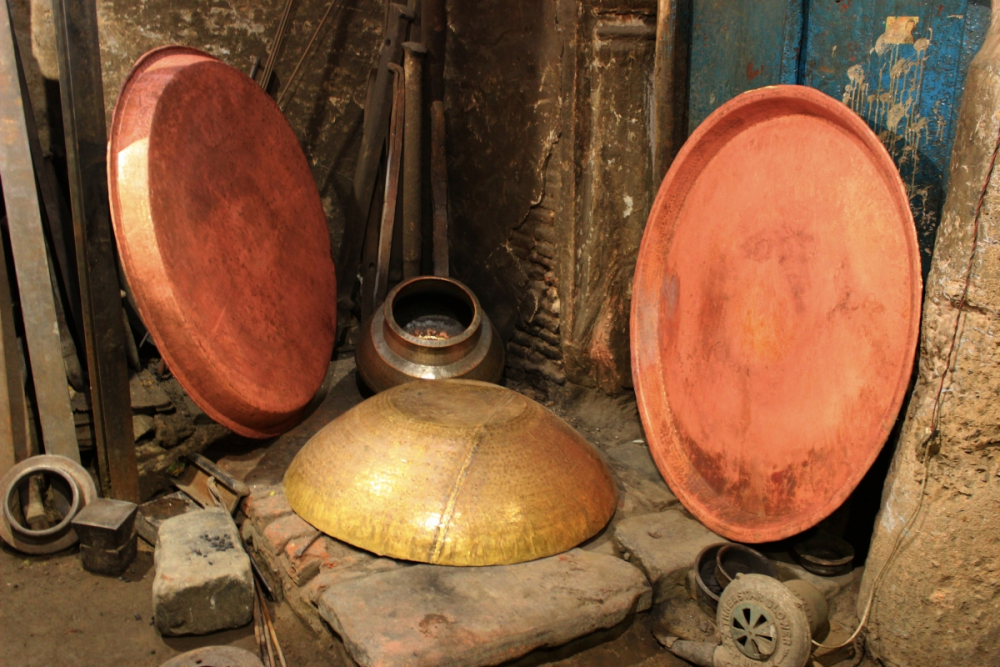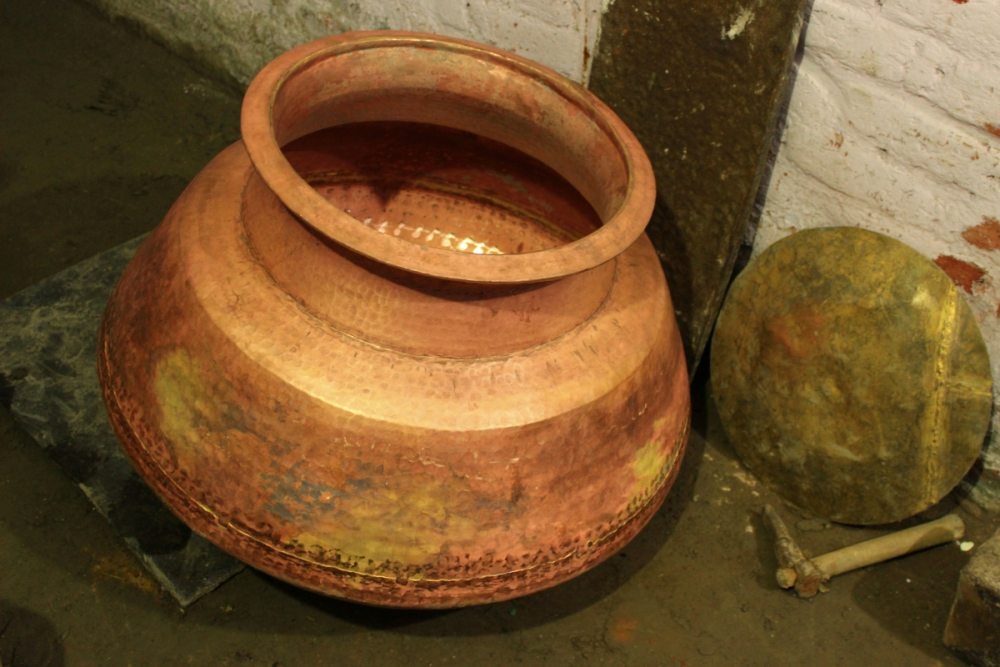Tucked in a by-lane of Sita Ram Bazar, in gali Sheesh Mahal, almost akin to an echo of the past that somehow escaped the ravages of time lies the locally respected karkhana (workshop) of Choudhary Kallu Mal, a thathera by profession whose name, like his legacy, has stuck so that the karkhana still goes by his name, several generations later. Vikas Metal Industries, ‘manufacturers’ of brass and copper utensils, specialists in making copper deghs and ek dal pateeli, reads the board further in both the official languages of colonial India, English and Hindustani Urdu.

More than 150 years old, the karkhana is representative of one of the oldest surviving professions of Dilli
More than 150 years old, the karkhana is representative of one of the oldest surviving professions of Dilli that is now fast disappearing. Even before we actually reach the workshop, its existence is announced with the ‘hammering sound’ of the thatheras shaping metal vessels, a dying auditory phenomenon that was once part of everyday sounds in the markets of the old city. Busy at work are Laxmi Narayan and his employed karigars (workers), one of four brothers who inherited this workshop from their father, and one of whom has passed away. Work in the karkhana is clearly demarcated into three different departments handled by the remaining three brothers to avoid any internal conflict. Dilliwalas for more than eight generations now, Laxmi Narayan is the grandson of Choudhary Kallu Mal, by whose name the workshop is locally known, so much so that anyone locally referred to their karkhana often mistakes Laxmi Narayan for Kallu Mal. Chhatri by caste and thatheras by profession, they are originally from Rajasthan (according to what they've heard from their elders) and Kallu Mal was the Choudhary (head) of their biradari (community), presiding over 12 villages around the city of Dilli. Their karkhana was amongst those rare workshops that were formally registered under the British Government of India. Laxmi Narayan recalls an incident in this context. In 1942, a fire broke out in a British office of Calcutta where the registration documents of such workshops were stored. The government had then issued a request asking all those people whose documents were lost in the fire to please send in a copy of their original registration papers for restoration.

Thatheras are the traditional makers of brass and copper utensils.
Thatheras are traditional artisans of the subcontinent, who manufacture brass and copper utensils. This craft has a unique ethnic and historical identity associated with it and the skills are passed from one generation to another orally. Metalwork is not simply a form of livelihood for the thatheras, but it defines their family and kinship structure, work ethic and status within society.
Traditionally made using metals like copper and brass (metals believed to be beneficial for health, recommended by the ancient Indian school of medicine, Ayurveda), with the advent of modernization, the thatheras of old Delhi also began using aluminium. Recently in 2014, the thathera community from Jandiala Guru, Punjab was accorded the honour of featuring on UNESCO’s List of Intangible Cultural Heritage (ICH), alongside other crafts like the Turkish art of marbling, and the Japanese technique of making hand-made paper, called Washi. The first time for a traditional craft from India to make it to this distinguished list, this rare honour however has not managed to translate into the preservation of this dying craft.

Laxmi Narayan informs us that the registration papers of Vikas Metal Industries that resurfaced in 1942 listed 5 items produced by their workshop under the British Raj, namely: degh, rangayi karne wali handi (vessel), dawai banana ka bhapka, lagan and a last object that he fails to recall. Now most of these vessels, except for the degh have run out of use. While other everyday articles that they used to make, such as, lotas, plates, thalis and objects of ritualistic value such as havan kunds made for pooja path have largely been replaced by cheaper steel alternatives. They even used to make tambe ke jahez ke bartan, part of a Muslim bride’s trousseau, usually 51 in number according to custom, these included household utensils such as a set of pateelis, katoriya, baltiya, lagan, glasses, lote etc. Utensils were thus manufactured for both ritual and utilitarian purposes, catering to individual needs as well as for community use on special occasions such as weddings or at temples.
Ek dal pateeli, that is, a pateeli made with a single sheet of metal without any joints, was something they specialized in, as the board reads. But Laxmi Narayan now laments the inability to continue doing something they took so much pride in.
There is so much milawat (adulteration) in raw materials these days, he complains, it is very difficult to get good quality metal and as a result the ek dal pateeli that we used to make now risks giving away while being used, toh taaka lagana padhta hai (we are forced to join more than one sheet). And the joint makes the customer suspicious, grahak kehte hai kya de rahe ho. Owing to the adulteration of raw material it is not possible to make a sturdy good quality pateeli in one piece anymore.

The art of manufacturing handcrafted products entails procuring flattened thin sheets of metal, imported from nearby states such as Haryana. These plates are then cut according to the need and hammered using hand tools into curved shapes, creating the required form, from small bowls and rimmed plates, to larger pots (pateelis) and huge cooking vessels (deghs), amongst other artifacts. Heating the plates to soften them while hammering and curving them into different shapes requires careful temperature control, which is achieved by using tiny wood-fired stoves (aided by hand-held bellows) buried in the earth. Vessels are then manually finished and polished. Designs are often made by skillfully hammering a series of tiny dents into the heated metal. There has been some technical advancement into machinery, for example, Laxmi Narayan shares, pehle gherai haath se karte the ab machine pe aa gaya hai bhaari kaam ke liye but, the craft otherwise entirely remains handcrafted. Haath ka kaam machine pe nahi ho sakta, he states as a matter of fact.

Despite its rich heritage and cultural value, the craft is fast waning as the thatheras today stand at the periphery of relevance. Earlier, this whole gali was filled with thatheras, Laxmi Narayan recalls poignantly, har ghar mai kaam hota tha and there were at least 50-60 karkhanas here. This is apart from the thatheras found in other parts of the old city. Phir bachche padhte gaye, nikalte gaye (children studied and took to jobs), he continues. Now only 4 karkhanas are left in the entire gali. I have seen these karkhanas disappear in front of my very eyes, within the last few decades, he informs.
Essentially an orally passed on traditional craft, thatheras still use hand-held tools and traditional wood-fired ovens to mould metal and it is not possible for them to compete with commercially mass-produced utensils. Also, with the advent of aluminium and steel utensils and their attractive qualities of long lasting durability, strength, light weight, easy maintenance and non-corrosive nature, pitted against the high maintenance of polishing, cleaning and tinning required by traditional metals, the usage of copper and brass has been completely relegated to the margins.
The key factor that orchestrated this transformation was that above everything else, steel as a commercially produced industrial object was a much cheaper and reliable alternative.
Besides, Laxmi Narayan plainly states that karigar nahi hai (there’s a dearth of labour). Today’s youth doesn’t want to do this work because it requires a lot of physical labour and mehnat (hardwork). This is a physically taxing job that requires one to devote at least 8 to 10 hours to the manufacturing process, which includes melting and hammering metal objects. And besides, pointing to a degh kept against the wall, Laxmi Narayan says that this is a 50 kg degh, ab utha lo jo utha sakta hai. Mehnat se ghabraate hai aaj ke time ke bachche.
The most recent implementation of GST has hit these small-scale craftsmen the most. Laxmi Narayan laments that there is now a straight 100 rupees increase in their production cost per degh while the customer is unwilling to share the burden.
 The last few bearers of the legacy of thathera community of Dilli, Vikas Metal Industries today primarily cater to local restaurants and hotels including the famous restaurants in and around the Jama Masjid area such as the Karim Hotel, Naaz Tandoor, Al Jawahar etc, they make for them deghs, pateeliya, katooriya etc on demand.
The last few bearers of the legacy of thathera community of Dilli, Vikas Metal Industries today primarily cater to local restaurants and hotels including the famous restaurants in and around the Jama Masjid area such as the Karim Hotel, Naaz Tandoor, Al Jawahar etc, they make for them deghs, pateeliya, katooriya etc on demand.

The last few bearers of the legacy of thathera community of Dilli, Vikas Metal Industries today primarily cater to local restaurants and hotels including the famous restaurants in and around the Jama Masjid area such as the Karim Hotel, Naaz Tandoor, Al Jawahar etc, they make for them deghs, pateeliya, katooriya etc on demand. They also cater to local exporters who demand hand-made utensils that are then exported abroad. These exporters are from cities like Gujarat, Hyderabad, and Bombay. Recently they had sent some vessels to an exporter in Gujarat who said that he will exports those to Saudi Arabia. Another product that they produce is pots used for plants that are also primarily exported.
They manufacture only when they get an order or demand for an article, this is because, since these products are handcrafted, it is not possible to produce them for mass commercial purposes. Though sometimes when there is excess an item, they have to sell it to retail shopkeepers in the market.
An interesting revelation has come to the fore solving the mystery behind the distinctive use of copper utensils in Muslim households and brass utensils in Hindu households of the old city of Delhi. This is because, Laxmi Narayan sheds some light, according to certain Hindu customs, you don't heat tamba (copper) because tamba apne mai dhaatu hai, it is a pure metal and it is not considered good to heat it. Even in mandirs (temples), you may find tambe ka lota or plate for it is a pure metal, but never as a cooking vessel that is heated. Therefore peetal (brass) is used instead.
When asked why the brass utensils used in Hindu households didn’t have intricate chetai (designing) whereas their counterpart copper utensils used in Muslim households used had extensive chetai, he answered with what sounded like a classic stereotype, othering the ‘other’. He replied that because Hindu households are particular about cleanliness and it is difficult to keep designed vessels clean because dirt and dust gets accumulated easily, therefore they are not used for cooking and eating food, implying the opposite for Muslim domestic spaces.
We only have designed products as decorative items, he continued, like the one hung on the wall of the karkhana or they are used for storing dry items such as gehu, anaaj, dal, chawal etc.

Will the next generation follow suit? The next generation is not joining the profession anymore, Laxmi Narayan answers decisively. Most children of the thathera community of old Delhi have taken up jobs, both in the public sector, doing government jobs as well as in the private sector, working in multinational corporations. Almost all of the sons of Laxmi Narayan’s family also do jobs except for Laxmi Narayan’s eldest son who helps his father out at the karkhana.
Laxmi Narayan’s grandson expresses great skepticism when I tell him about the thatheras being featured on the UNESCO List. He recalls when he was a young boy; a foreign PhD researcher had stayed with them for about a month or so, as part of his fieldwork on metal crafts. He used to eat with us, sing with us and spend all the time with us, he recollects with a faint smile and it eventually culminated into an exhibition at Vigyan Bhawan. And then we thought something would come out if it, but nothing happened. Then there was this other researcher from London, perhaps a botanist (but he is not sure) who was working with plants and took metal pots along with him to London. Sometimes research students from Sanskriti Bhawan working on projects related to metal products come here for fieldwork. Most recently, they handcrafted the gumbad of Humayun’s Tomb as part of a restoration project sponsored by the Agha Khan Trust and Laxmi Narayan was honoured in a ceremony for the same. But it all just ends there, he complains earnestly.
Ending rather solemnly he says, I wanted to do this work, mai chahta tha ki mai iss kaam ko badau, but after a point of time my father only asked me to go out for there is nothing here. I now do a government job.
With no support from the government, this profession has declined rapidly, the community is suffering and it seems that this craft destined for a certain death. Fast disappearing from the memory of the city of Dilli and its people, the thatheras might soon be a lost sound, perhaps only left in Hindi alphabet books teaching the letter, ‘th’ se thathera.













